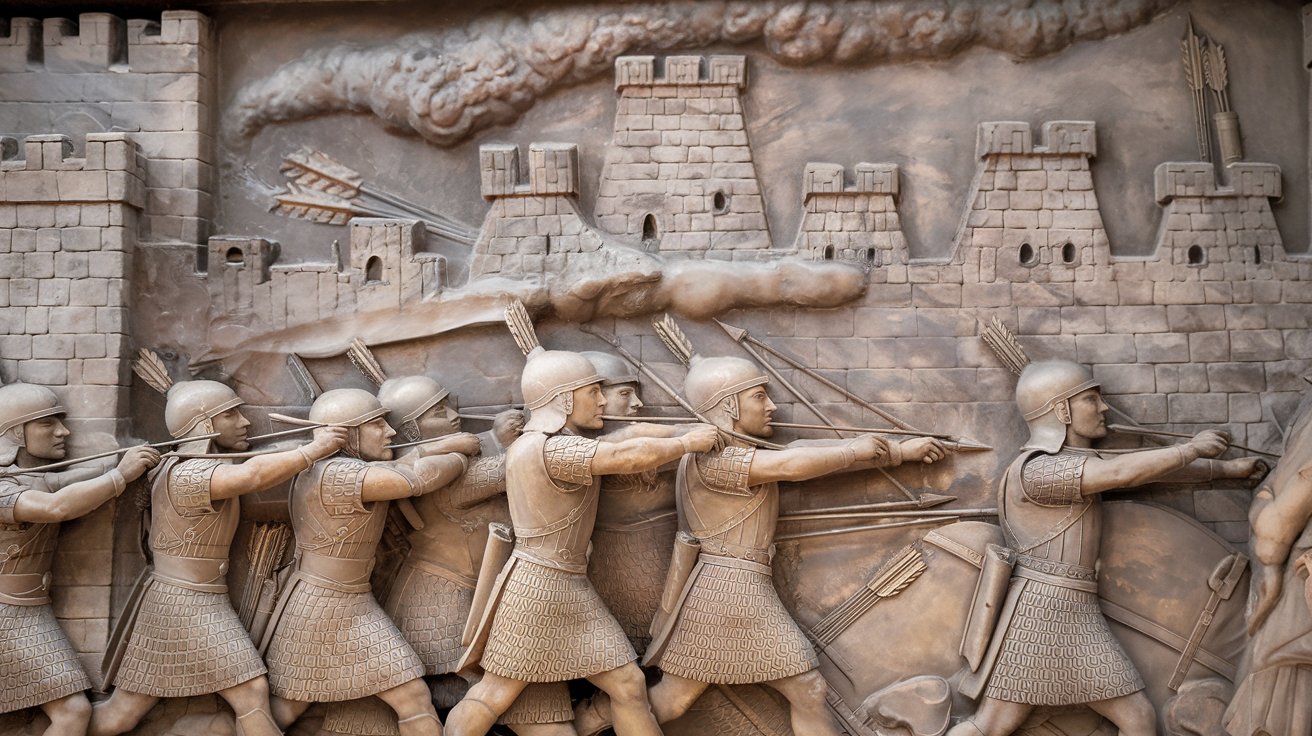
The Assyrian conquest of Aram, spanning from 856 to 732 BCE, reshaped the ancient Near East. This period saw the Neo-Assyrian Empire, a powerhouse from 911 to 605 BCE, expand its territory through relentless military campaigns. The region, now modern Syria, Lebanon, Palestine, and northern Jordan, was home to various Aramean kingdoms like Aram-Damascus and Hamath. These kingdoms, along with Phoenician city-states and Canaanite-speaking kingdoms, faced the might of Assyrian rulers such as Tiglath-Pileser III. The conquest not only altered political landscapes but also left a lasting cultural impact, influencing language, architecture, and regional politics for centuries.
Key Takeaways:
- The Assyrian Conquest of Aram, from 856 to 732 BCE, reshaped the ancient Near East, impacting the region's politics, culture, and language, leaving a lasting historical legacy still felt today.
- The conquest saw the Neo-Assyrian Empire expand its borders, incorporating various Aramean, Phoenician, Sutean, and Neo-Hittite states, leading to significant administrative and cultural changes in the region.
The Assyrian Conquest of Aram: A Transformative Era
The Assyrian conquest of Aram, spanning from 856 to 732 BCE, reshaped the ancient Near East. This period saw the Neo-Assyrian Empire expand its borders, incorporating various Aramean, Phoenician, Sutean, and Neo-Hittite states. Let's dive into 25 key facts about this transformative era.
Duration and Scope of the Conquest
Understanding the timeline and geographical reach of the Assyrian conquest provides a foundation for grasping its impact.
-
Duration and Scope: The conquest lasted from around 856 to 732 BCE, covering modern Syria, Lebanon, Palestine, and northern Jordan.
-
Neo-Assyrian Empire: The Neo-Assyrian Empire, existing from 911 to 605 BCE, was the driving force behind these conquests.
The Aramean Kingdoms and Their Struggles
The region was home to various Aramean kingdoms, each with its own unique challenges and interactions with the Assyrians.
-
Aramean Kingdoms: Dominated by kingdoms like Aram-Damascus, Hamath, and Bit Adini, these states often clashed with the Assyrians.
-
Phoenician City States: Coastal cities like Tyre and Sidon thrived in maritime trade, managing to survive the collapse of other states.
-
Sutean and Arab Tribes: Eastward, Sutean and Arab tribes formed confederations in the Syrian Desert and Middle Euphrates region.
-
Canaanite-Speaking Kingdoms: In Palestine and Transjordan, kingdoms like Israel, Judah, Ammon, Edom, and Moab interacted with both Assyrians and Arameans.
Early Assyrian Campaigns
The initial phases of Assyrian expansion set the stage for later conquests.
-
Assyrian Conquest Under Adad-nirari II: Beginning in 911 BCE, Adad-nirari II drove Arameans from Assyrian territory in Tur-Abdin and the Khabur region.
-
Tiglath-Pileser III’s Conquests: Ascending in 744 BCE, Tiglath-Pileser III initiated campaigns that led to the subjugation of the entire Levant.
Key Battles and Turning Points
Significant battles and events marked the Assyrian conquest, altering the region's political landscape.
-
Conquest of Aram-Damascus: In 732 BCE, Tiglath-Pileser III destroyed Aram-Damascus, deporting its population and executing King Rezin.
-
Aramean Tribal Confederations: Distinct tribes sought to dominate specific territories, often clashing with the Assyrians.
-
Tell Ahmar and Til Barsib: The Aramaean city of Tell Ahmar, known as Til Barsib, became an important Assyrian administrative center after its conquest.
Middle Assyrian Period and Earlier Conflicts
The roots of Assyrian-Aramean conflicts date back to the Middle Assyrian period.
-
Middle Assyrian Period: Around 1100 BCE, kings like Tiglath-pileser I and Aššur-bêl-kala fought Aramaeans along the Euphrates river.
-
Late Bronze Age Collapse: The collapse of centralized structures led to a reversion to tribal forms of organization, creating instability.
-
Ahlamû and Aramaeans: The Ahlamû, associated with the Aramaeans, fomented unrest along the Euphrates river.
-
Middle Assyrian Kings: Efforts by Tiglath-pileser I and Aššur-bêl-kala to restore Assyrian power in the Middle Euphrates region were ultimately unsuccessful.
Cultural and Administrative Changes
The Assyrian conquest brought significant cultural and administrative changes to the region.
-
Aramaean City States: By the 10th century BCE, Aramaeans organized into tribes that seized power in various cities.
-
Syro-Hittite Style and Luwian Inscriptions: The ruling elite at Tell Ahmar used stelae and reliefs in Syro-Hittite style, with inscriptions in the Luwian language.
-
Assyrian Empire Building: The encounter at Tell Ahmar marked a process of Assyrian empire building through military conquests and administrative reforms.
The Fall of Israel and Judah's Appeal
The Assyrian conquest also impacted the Biblical kingdoms of Israel and Judah.
-
Conquest of Israel: In 722 BCE, Shalmaneser V conquered the Northern Kingdom of Israel, deporting its population and incorporating it into the Assyrian Empire.
-
Tiglath-Pileser III’s Campaigns: His extensive campaigns against Israel and Aram-Damascus led to the destruction of Aram-Damascus.
-
Ahaz’s Appeal to Tiglath-Pileser III: King Ahaz of Judah sought help against the Arameans and Israelites, leading to the annexation of Aram.
Administrative Reforms and Cultural Impact
Post-conquest, the Assyrians implemented reforms and influenced local cultures.
-
Assyrian Administrative Reforms: New provinces were established, and governors appointed to oversee local governance.
-
Cultural Impact: The spread of Assyrian culture and language influenced local populations, evident in the use of Aramaic as a lingua franca.
Historical Legacy and Regional Politics
The legacy of the Assyrian conquest continues to shape the region's history and politics.
-
Historical Legacy: The term "Syria" originated from the Assyrian name for the region, Eber-Nari, later adopted by the Greeks.
-
Regional Politics: The incorporation of various Aramean kingdoms into the Assyrian Empire created a complex web of alliances and rivalries.
Lasting Impact of the Assyrian Conquest
The Assyrian conquest of Aram reshaped the ancient Near East. Spanning from 856 to 732 BCE, this period saw the Neo-Assyrian Empire dominate regions like modern Syria, Lebanon, Palestine, and northern Jordan. The conquest integrated various Aramean kingdoms, Phoenician city-states, and Canaanite-speaking kingdoms into the Assyrian fold. Kings like Tiglath-Pileser III and Shalmaneser V led these campaigns, altering the political landscape and influencing local cultures. The spread of Assyrian culture and language left a lasting mark, evident in the widespread use of Aramaic. The term "Syria" itself originates from the Assyrian name for the region. This conquest not only expanded Assyrian territory but also set the stage for future empires, creating a complex web of alliances and rivalries that shaped the region's history for centuries. The Assyrian legacy continues to influence our understanding of ancient civilizations.
Frequently Asked Questions
Was this page helpful?
Our commitment to delivering trustworthy and engaging content is at the heart of what we do. Each fact on our site is contributed by real users like you, bringing a wealth of diverse insights and information. To ensure the highest standards of accuracy and reliability, our dedicated editors meticulously review each submission. This process guarantees that the facts we share are not only fascinating but also credible. Trust in our commitment to quality and authenticity as you explore and learn with us.


